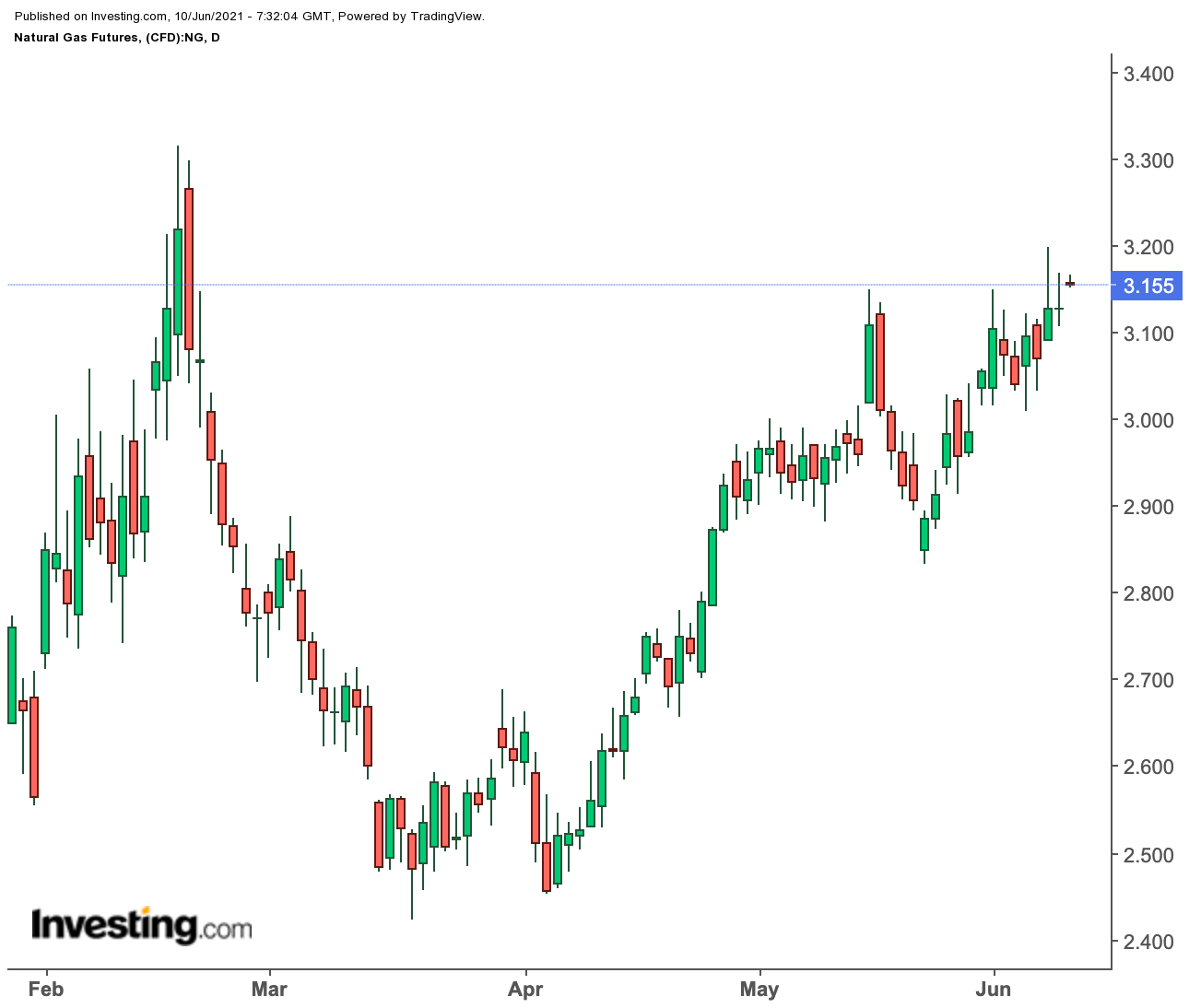Buckle up: The bucking bronco of natural gas could return.
After weeks of relative tranquility that belied the inherent nature of one of the energy sector’s most volatile markets, natural gas prices might be ready to swing again on demand uncertainty linked to summer weather and the duration of maintenance at liquefaction facilities for US LNG (Liquified Natural Gas).

Natural gas prices have risen in eight of the past nine weeks—phenomenal for a commodity that typically has difficulty staying in one direction beyond three weeks.
US gas production has surprised to the upside in recent months, mainly driven by the Appalachian region, taking May storage injections well above market expectations.
Despite the higher inventory levels, the storage balance for 2021 remains significantly tighter than last year. This is characterized by the summer opening stocks, which came in at more than 200 bcf, or billion cubic feet, below last year’s level, and to-date injections now standing almost 180 bcf lower.
With the Northern Hemisphere at the cusp of its peak summer season, weather forecasts point to above-average cooling demand in June, supporting US power burns.
The arbitrage for exports of LNG remains wide open, driven by tighter global gas balances, supporting strong LNG feed-gas demand. US oil drilling has also continued to reflect producer discipline, moderating growth of associated gas production.
Yet, the upside in natural gas may not continue for too long—at least by the estimates of analysts at Goldman Sachs.
“We are not calling the top for US gas prices at current levels, but more symmetric price risks from here lead us to take this opportunity to close our long,” Goldman analysts Samantha Dart, Damien Courvalin, and Huan Wei said in a natural gas note distributed Wednesday.
The argument the trio makes is that current gas prices were consistent with what was necessary to manage US gas storage ahead of the coming winter, with risks symmetrically distributed. Yet, with summer having barely begun, much uncertainty remains about the intensity of cooling demand in the coming months and how long US LNG liquefaction plants will be decommissioned for maintenance, affecting exports of the fuel, they noted.
“This uncertainty, combined with potentially higher-than-expected US gas production growth (including a potential revision of today’s preliminary data point), will likely bring further price volatility,” the Goldman analysts concluded.
At Wednesday’s settlement, natural gas futures for July delivery on the New York Mercantile Exchange’s Henry Hub was virtually flat at $3.129 per mmBtu, or million metric British thermal units.
The balance of the Henry Hub strip for summer through March 2022, or spring next year, also settled above $3.
Those settlements came ahead of the Energy Information Administration’s weekly storage report on natural gas, due at 10:30 AM ET (14:30 GMT) today.
A consensus of analysts tracked by Investing.com are forecasting an injection of 98 bcf into storage for the week ended June 4, versus the 95bcf build during the same week a year ago and the five-year (2016-2020) average injection of 92 bcf.
In the previous week to May 28, utilities injected 98 bcf into storage—the same as forecast by analysts for this Thursday’s EIA report.
If those estimates are on target, the injection during the week ended June 4 would take stockpiles up to 2.411 tcf, or trillion cubic feet, some 2.4% below the five-year average and 13.7% below the same week a year ago.
Mild Temperatures To Heat Waves
According to a temperature reading by data provider Refinitiv, last week’s conditions were slightly milder than normal, with just 60 TDDs, or total degree days, versus a 30-year average of 65 TDDs for the period.
TDDs are used to estimate demand to heat homes and businesses, measuring the number of degrees a day's average temperature is below 65 degrees Fahrenheit (18 degrees Celsius).
Notwithstanding the TDD readings, the current heat wave in Texas and along the Gulf Coast was the primary driver of Wednesday’s price gains on the Henry Hub, according to NatGasWeather.
In a blog by industry portal naturalgasintel.com, NatGasWeather said the European Center (EC) and the American Global Forecast System (GFS) models each added a few cooling degree days overnight.
NatGasWeather also noted that while LNG feed gas remained well off record highs at around 8.8 bcf, the drop was partially countered by strong exports to Mexico that have been running near 7.0 bcf a day.
NatGasWeather expects the weather pattern for the June 22-27 period to be of increasing importance in the coming days.
Both the GFS and EC data had teased at stronger demand, with upper high pressure over the West shifting over the southern United States, the forecaster said, adding that the midday GFS run “was a little slower in its development to lose a little demand for June 21-23.”
Strong heat was seen continuing through the weekend, but then easing to more seasonal next week as hot high pressure was forecast to shift over the western half of the country, NatGasWeather said. In the eastern third of the country, more comfortable temperatures were expected, along with showers, it added.
“This cooler-than-normal pattern over the eastern US,”—(forecast to run from Tuesday through June 21)—“is what’s preventing the pattern from being considered solidly bullish,” the forecaster said.
Disclaimer: Barani Krishnan uses a range of views outside his own to bring diversity to his analysis of any market. For neutrality, he sometimes presents contrarian views and market variables. He does not hold a position in the commodities and securities he writes about.
